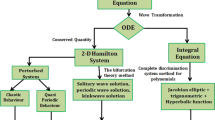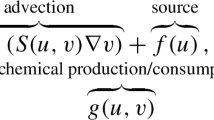Abstract
It is known that Turing systems in two dimensions produce spotted, striped, and labyrinthine patterns. In three dimensions, a greater variety of patterns is possible. By numerical simulation of the FitzHugh-Nagumo type of reaction-diffusion system, we have obtained not only lamellar, hexagonal and spherical structures (BCC and FCC) but also gyroid, Fddd, and perforated lamellar structures. The domains of these three structures constitute interconnected regular networks, a characteristic occurring in three dimensions. Moreover, we derive the Lyapunov functional by reducing the system, and we evaluate this functional by introducing the asymptotic solutions of each structure by the mode-expansion method and direct simulation of the time evolution equation.
Similar content being viewed by others
References
H. Meinhardt, Models of Biological Pattern Formation. Academic Press, London, 1982.
J.D. Murray, Mathematical Biology. Springer-Verlag, New York, 2003.
A.M. Turing, The chemical basis of morphogenesis. Phil. Trans. R. Soc. Lond. B,237 (1952), 37–72.
G. Nicolis and I. Prigogine, Self-Organization in Nonequilibrium Systems. Wiley, New York, 1977.
P. De Kepper, E. Dulos, J. Boissonade, A. De Wit, G. Dewel and P. Borckmans, Reactiondiffusion patterns in confined chemical systems. J. Stat. Physic,101 (2000), 495–508.
V. Castets, E. Dulos, J. Boissonade and P. De Kepper, Experimental-evidence of a sustained standing Turing-type nonequilibrium chemical-pattern. Phys. Rev. Lett.,64 (1990), 2953–2956.
H. Haken, Synergetics, An Introduction. Springer-Verlag, Berlin, 1977.
A. De Wit, G. Dewel, P. Borckmans and D. Walgraef, 3-dimensional dissipative structures in reaction diffusion-systems. Physica D.,61 (1992), 289–296.
A. De Wit, P. Borckmans and G. Dewel, Twist grain boundaries in three-dimensional lamellar Turing structures. Proc. Nat. Acad. Sci.,94 (1997), 12765–12768.
T. Leppanen, M. Karttunen, R. Kaski, R. A. Barrio and L. Zhang, A new dimension to Turing patterns. Physica D.,168 (2002), 35–44.
H. Shoji, K. Yamada and T. Ohta, Interconnected Turing patterns in three-dimensions. Phys. Rev. E,72 (2005), 65202(R).
H. Shoji, K. Yamada, D. Ueyama and T. Ohta, in review.
R. FitzHugh, Impulses and physiological states in theoretical models of nerve membrane. Biophys. J.,9 (1961), 445–466.
J. Nagumo, R. Arimoto and S. Yoshizawa, Active pulse transmission line simulating nerve axon. Proc. IRE,50 (1962), 2061-?.
J. Rinzel and J.B. Keller, Travelling-wave solutions of a nerve-conduction equation. Biophys.,13 (1973), 1313–1337.
J.J. Tyson and J.P. Keener, Singular perturbation-theory of traveling waves in excitable media. Physica D.,32 (1988), 327–361.
I. Prigogine and R. Lefever, Symmetry breaking instabilities in dissipative systems. 2. J. Chem. Phys.,48 (1968), 1695–1700.
P. Gray and S.K. Scott, Autocatalytic reactions in the isothermal, continuous stirred tank reactor-isolas and other forms of multistability. Chem. Eng. Sci.,38 (1983), 29–43.
A. Shinozaki and Y. Oono, Spinodal decomposition in 3-space. Phys. Rev. E,48 (1993), 2622–2654.
A. Aksimetiev, M. Fialkovski and R. Holyst, Morphology of surfaces in mesoscopic polymers, surfactants, electrons, or reaction-diffusion systems: Methods, simulations, and measurements. Adv. Chem. Phys.,121 (2002), 141–239.
K. Yamada, M. Nonomura and T. Ohta, Kinetics of morphological transitions in microphaseseparated diblock copolymers. Macromolecules,37 (2004), 5762–5777.
T. Ohta, Decay of metastable rest state in excitable reaction-diffusion system. Prog. Theo. Phys. Suppl.,99 (1989), 425–441.
Author information
Authors and Affiliations
Corresponding author
About this article
Cite this article
Shoji, H., Yamada, K. Most stable patterns among three-dimensional Turing patterns. Japan J. Indust. Appl. Math. 24, 67–77 (2007). https://doi.org/10.1007/BF03167508
Received:
Revised:
Issue Date:
DOI: https://doi.org/10.1007/BF03167508




